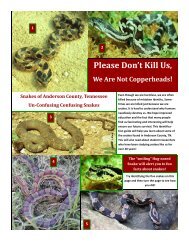Lichen Lesson - Great Smoky Mountains Institute at Tremont
Lichen Lesson - Great Smoky Mountains Institute at Tremont
Lichen Lesson - Great Smoky Mountains Institute at Tremont
Create successful ePaper yourself
Turn your PDF publications into a flip-book with our unique Google optimized e-Paper software.
EFFECTS OF<br />
AIR POLLUTION<br />
LICHEN<br />
MONITORING<br />
extension activity).<br />
Procedure:<br />
(Steps 1-3 can be done in a separ<strong>at</strong>e<br />
class period if necessary)<br />
1. Students will need to know<br />
how to find the cardinal directions<br />
(North, South, East, West) using<br />
a compass. This step is important<br />
if you are setting up a long-term<br />
monitoring study. If you need instructions,<br />
please go to the website<br />
: http://www.learn-orienteering.<br />
org/old/lesson1.html<br />
2. Show students how to classify<br />
lichens into their three morphological<br />
groups, ID moss and bare bark.<br />
3. Show students how to read the<br />
d<strong>at</strong>a sheet, also have them fill out<br />
important inform<strong>at</strong>ion before going<br />
to their study tree (such as today’s<br />
d<strong>at</strong>e, group name, loc<strong>at</strong>ion).<br />
4. Explain to students which side<br />
of the tree you would like them to<br />
begin collecting (north, south, east,<br />
west). Remind them to use their<br />
compass to find th<strong>at</strong> side.<br />
5. Have students <strong>at</strong>tach their transparency<br />
grid to the appropri<strong>at</strong>e side<br />
of the tree using the clothes pins.<br />
6. Have students measure and record<br />
the tree’s circumference <strong>at</strong> the<br />
middle of their <strong>at</strong>tached transparency<br />
(4 ½ feet up from the ground).<br />
7. Have students estim<strong>at</strong>e and record<br />
the canopy cover when standing<br />
underne<strong>at</strong>h their study tree.<br />
8. Have students classify the lichen<br />
type found under each of the<br />
circle in square 1. Record this on<br />
the d<strong>at</strong>asheet in the square labeled<br />
“1”. They should have 10 marks in<br />
each square since all circles can be<br />
classified into one of the c<strong>at</strong>egories<br />
(crustose, fruticose, foliose, bare<br />
bark, moss).<br />
9. Repe<strong>at</strong> the previous step for all 9<br />
boxes.<br />
10. Follow the instructions on the<br />
d<strong>at</strong>asheet to calcul<strong>at</strong>e the total<br />
lichen coverage for th<strong>at</strong> side of the<br />
tree. [Count total number of marks<br />
for each lichen type, bare bark, and<br />
moss. Divide the number for each<br />
lichen type, bare bark, and moss by<br />
90 to get a decimal. Multiply these<br />
decimals by 100 to get the percentage<br />
of lichen coverage.]<br />
11. If time allows, do another side<br />
of the tree or the next class period<br />
can complete another side of the<br />
tree.<br />
Quality Assurance: To ensure th<strong>at</strong><br />
d<strong>at</strong>a are accur<strong>at</strong>e, you can have<br />
more than one group survey each<br />
tree. If the d<strong>at</strong>a m<strong>at</strong>ch, it can be accepted,<br />
if not, the tree will need to<br />
be reassessed.<br />
Extension activity #1: Have your<br />
students ID and record the tree<br />
species they are studying or you<br />
can do th<strong>at</strong> for them.<br />
Extension activity #2: Have your<br />
students measure the pH of the<br />
bark of their tree. Remove small<br />
piece of bark, soak it 24 hours in<br />
distilled w<strong>at</strong>er (pH 7) and then test<br />
it with a pH strip or meter.<br />
Wrap Up:<br />
Regroup the students and review<br />
the d<strong>at</strong>a collected. If you had different<br />
species of trees, was there<br />
any difference in lichen coverage?<br />
Why might there be a difference?<br />
(pH of the bark is one probable<br />
explan<strong>at</strong>ion) Is one lichen growth<br />
form more common than the others?<br />
Which one? The most sensitive<br />
types of lichens tend to be the ones<br />
th<strong>at</strong> protrude the furthest from the<br />
tree.<br />
In the <strong>Gre<strong>at</strong></strong> <strong>Smoky</strong> <strong>Mountains</strong><br />
N<strong>at</strong>ional Park, we are checking to<br />
see if we are losing more sensitive<br />
types of lichens (a foliose group<br />
called Lung lichens or Lobaria)<br />
and looking to see if they are being<br />
replaced by lichens more tolerant<br />
to acidic environments (typically<br />
crustose lichens since they have<br />
less of a surface area to volume<br />
r<strong>at</strong>io).<br />
D<strong>at</strong>a Analysis: Students can cre<strong>at</strong>e<br />
pie or bar graphs of the classific<strong>at</strong>ion<br />
of coverage by tree species<br />
and/or tree species by lichen composition.<br />
Ideally, this d<strong>at</strong>a should<br />
be saved each year so students can<br />
compare their d<strong>at</strong>a with previous<br />
year(s). If this is being done,<br />
is there any change over time?<br />
This can be illustr<strong>at</strong>ed with a line<br />
graph showing percent coverage by<br />
lichen type and tree species.<br />
Reference Books<br />
• <strong>Lichen</strong>s of North America. Irwin<br />
Brodo, Sylvia Duran Sharnoff and<br />
Stephen Sharnoff.<br />
• <strong>Lichen</strong>s. William Purvis<br />
Parks as Classrooms <strong>Gre<strong>at</strong></strong> <strong>Smoky</strong> <strong>Mountains</strong> N<strong>at</strong>ional Park<br />
<strong>Lichen</strong>s 2


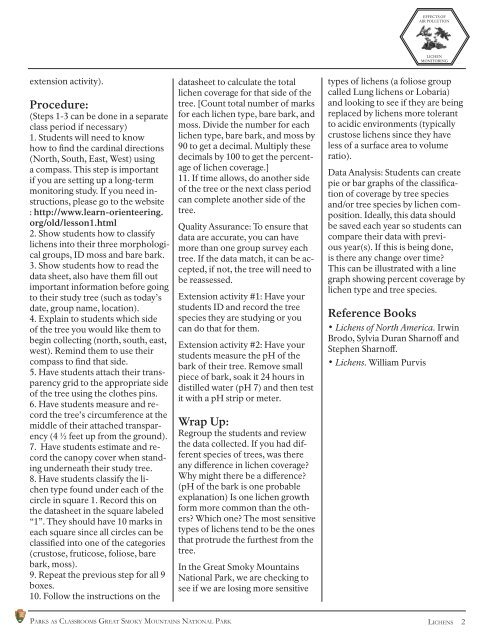
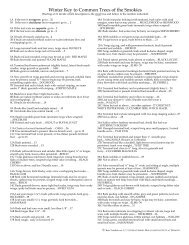

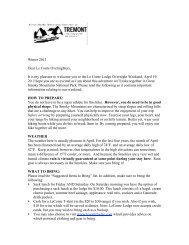
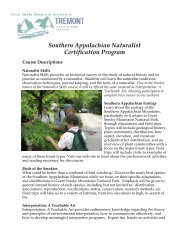

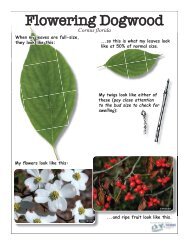
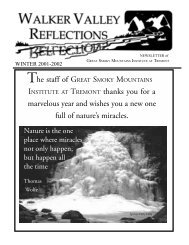
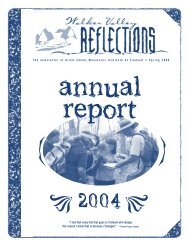
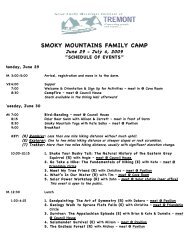
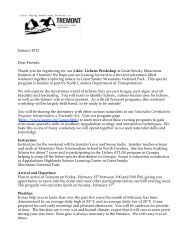
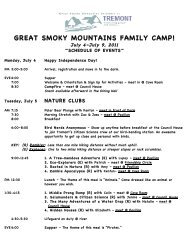
![Application [PDF] - Great Smoky Mountains Institute at Tremont](https://img.yumpu.com/22110613/1/190x245/application-pdf-great-smoky-mountains-institute-at-tremont.jpg?quality=85)
